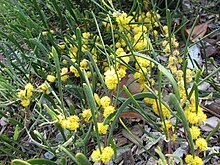| Mealy wattle | |
|---|---|

| |
| Scientific classification | |
| Kingdom: | Plantae |
| Clade: | Tracheophytes |
| Clade: | Angiosperms |
| Clade: | Eudicots |
| Clade: | Rosids |
| Order: | Fabales |
| Family: | Fabaceae |
| Subfamily: | Caesalpinioideae |
| Clade: | Mimosoid clade |
| Genus: | Acacia |
| Species: | A. farinosa |
| Binomial name | |
| Acacia farinosa Lindl. | |

| |
| Occurrence data from AVH | |
| Synonyms | |
|
Racosperma farinosa Pedley | |
Acacia farinosa, commonly known as mealy wattle, is a shrub that is endemic to Australia. It grows to between 1 and 2 metres high and has ascending phyllodes. The yellow globular flower heads generally appear between August and October in its native range. These are followed by curled and twisted pods which are up to 6 cm long and 2–3 mm wide.
The species was formally described by English botanist John Lindley in 1838 from material collected on Thomas Mitchell's expedition near Lake Charm, Victoria in 1836. The description was published in Mitchell's Three Expeditions into the interior of Eastern Australia. The name Acacia whanii F.Muell. ex Benth. has been misapplied to this species.
The species occurs naturally in shrubland and woodland in South Australia and Victoria. It often occurs in association with Eucalyptus incrassata and Melaleuca uncinata.
Cultivation
The species may be used as a groundcover in coastal areas.
References
- ^ "Acacia farinosa". Australian Plant Name Index (APNI), IBIS database. Centre for Plant Biodiversity Research, Australian Government, Canberra. Retrieved 2009-09-17.
- ^ "Acacia farinosa". World Wide Wattle. Retrieved 2009-09-17.
- ^ "Acacia farinosa". Electronic Flora of South Australia Fact Sheet. State Herbarium of South Australia. Retrieved 2009-09-17.
External links
- Three Expeditions into the Interior of Eastern Australia, Volume 1 by Mitchell at Project Gutenberg
- Three Expeditions into the Interior of Eastern Australia, Volume 2 by Mitchell at Project Gutenberg